Making trams from card or paper
Posted
Full Member
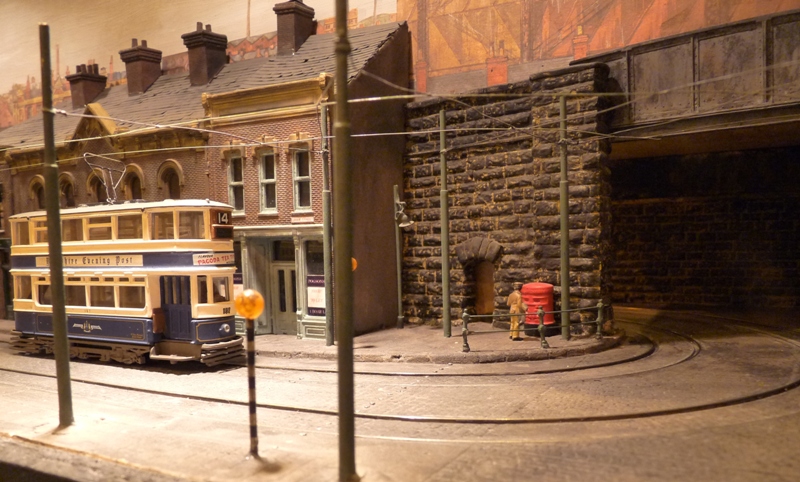
As you say, the cost of brass tube makes the poles very expensive. I might do some experiments with either steel tube or even steel rod. Heavier but, as the layout won't be portable, it may not matter that much.
I wonder if they put a slight zig-zag in the overheads like they do on railway catenery to spread bow wear over a wider area………….:roll::roll::roll:
'Petermac
Posted
Full Member
If you take the prototype example we can make the poles from wood or plastic as there should be no current flowing through them. I admit there may be strength issues but it's worth a try to find out.
As far as zigzag goes that was always intended as it was standard prototype practice. Where do you think the railways got the ideaI wonder if they put a slight zig-zag in the overheads like they do on railway catenery to spread bow wear over a wider area………….:roll::roll::roll:
Jim
Because, except in some unfortunate circumstances, trains did not run on town centre streets
Posted
Full Member
This is the address if you want chapter and verse on automatic stop/start systems
Code
http://www.gordonstrams.net/index.htmGreat info
Jim
Because, except in some unfortunate circumstances, trains did not run on town centre streets
Posted
Full Member
What he doesn't know about tram modelling, probably isn't worth knowing. He was around in the days of ABS, BEC and Tramalan etc.
'Petermac
Posted
Full Member
You said
So was I mate. He just got stuck in and continued to improve and gain knowledge & experience but I was a sinner Lord and fell by the wayside.:oops::oops::oops:He was around in the days of ABS, BEC and Tramalan etc.
Got a letter from Adrian B, Swain (ABS) somewhere but, I was in the Fleet Air Arm and freshly married with no room for a layout or anything. Mind you in 1968 I DID get to do something that not many railway enthusiasts who didn't work for a railway company get to do, I drove one of my subject models real life counterparts through the streets of Rio De Janeiro and over this little number thanks to a couple of quid and an enamel Glasgow tram badge. The driver let me have a go over this as it was not on the public street and the only place we would not be seen.
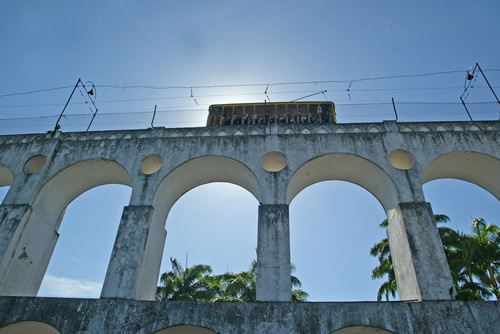

The damage is from a fall from the track. Two feet onto a plywood surface, she still runs fine and the cracks have been repaired but I wont post a picture until I have done the repaint. This may take a while because one of the advantages of card trams is that they eliminate one of my least favorite jobs, painting.
If you have the site on bookmark have a look at his auto stop for two rail. No DCC kit needed. I have printed out the instructions and wonder if we can publish it here providing we credit it to the Author?
Regards
Jim
If you have the site on bookmark have a look at his auto stop for two rail. No DCC kit needed. I have printed out the instructions and wonder if we can publish it here providing we credit it to the Author?
Regards
Jim
 Last edit: by The Bankie
Last edit: by The Bankie
Because, except in some unfortunate circumstances, trains did not run on town centre streets
Posted
Full Member
Yes, the rail break system is used by a number of tram modellers. I recall seeing a layout once that in retrospect was obviously using the system but at the time I did not realise it.
What attracted me to the system was the fact that the layouts using it are in continuous operation. So many layouts one sees at exhibitions are obviously the p and j of their owners but to the casual observer resemble paint drying. Not something I have ever been able to accuse a tram layout of.
Also I like the idea of bow collectors. Not to difficult to make and very practical. Only snag is the need for manual intervention when reversing; unless of course someone knows different; on an end to end circuit. Great for ovals and dog bones though.
freelance model railways and tramways
index02
index02
Posted
Full Member
Do the reversing the prototype way. Where you want to reverse allow some slack in the overhead. as your tram backs up the bow will rise and flip over. You may need to have some form of resistance to make it flip but it will do it PROVIDING your bow is sprung to work in both directions. My Coronation has an early bow which is only sprung one way.
Trolley poles are even worse as, if you do not have a little man to come out and pull the pole round, you need a trolley reverser (think of it as a railway reversing triangle on your overhead). It works well enough but you will need to use some form of trough for it as the trolley will never stay on in 00.
Since you are freestyle you can use a pantograph. No problems at all.
One way of getting a trolley pole to work is to use a very high number (20?) BA slot head screw and fix it to the pole allowing it to swivel and soldering or painting over the nut fastening it to keep it in place and it can be brass for better conductivity.
Regards
Jim
 Last edit: by The Bankie
Last edit: by The Bankie
Because, except in some unfortunate circumstances, trains did not run on town centre streets
Posted
Full Member
I wondered if a bow would flip. Did not realise it was a system actually used.
I have considered pantographs, but being a tight 'b…' when it comes to hobbies I reckon bow collectors are the easiest to make of the three types, especially at the smaller scales. I actually made one once, must dig it out and progress further.
Thanks for the info.
David
PS just realised I uploaded a picture of it.
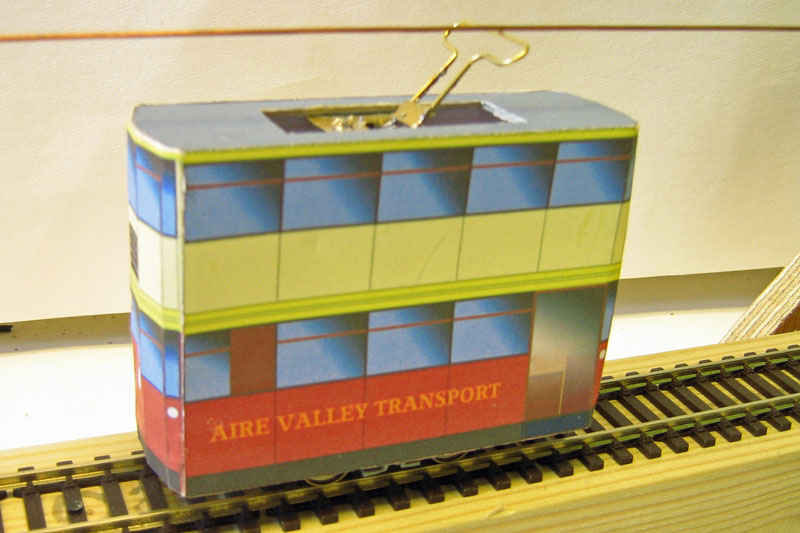
 Last edit: by wahiba
Last edit: by wahiba
freelance model railways and tramways
index02
index02
Posted
Full Member
Nice one. :doublethumb
Remember that pantographs can be single arm cranked, or double arm diamond. If you go for a single arm a trolley pole bent at an acute angle and with a crossbar replacing the wheel you have your pantograph. It is not necessary for both arms to be sprung.
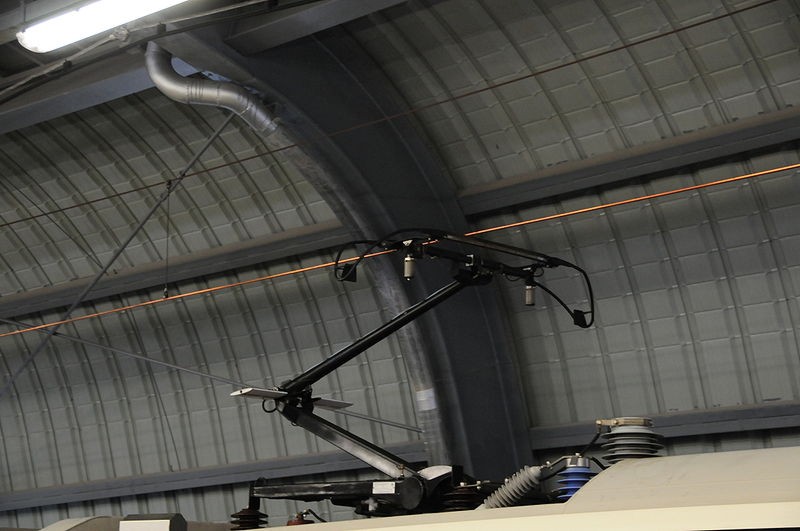
Or you can go REALLY antique a la Manx Snaefell cars.
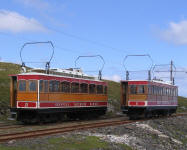
Not certain if these are bow or pantograph but in our case a little bit of spring steel for the upright makes your spring.
Regards
Jim
Because, except in some unfortunate circumstances, trains did not run on town centre streets
Posted
Full Member
Certainly my memory of Leeds trams was that the conductor got out at the end of the line and pulled the bow round with a piece of rope whilst the driver walked to the other end of the tram carrying his "handles" ready to plug in to the stalks at the new "front end". :thumbs
Occasionally, although I don't really remember where it saw it, there was a "turning circle" where the tram simply went round a tight 360 deg. curve (Middleton or Temple Newsham maybe ? :roll::roll:). I know pole collectors sometimes used a clever "reversing loop" although again, I think more often than not, it was the conductor who swung the arm around. A certain amount of "dexterity" was required to re-wire it because the spring was quite hefty…………:shock::shock: Bows naturally, only needed to get close. ;-)
In passing, I came across this site the other day:
The Ghosts of the Leeds tram cars | Derelict Places - Urban Exploring Forum
'Petermac
Posted
Full Member
You are pretty close in that it wasn't an automatic action. In Glasgow the bow had a cord hanging down at front and back and the conductor had to open the front window and pull it over. Whether or not the tram drove forwards as this was being done I don't know. The bow was not, as far as I know, on a swivel.
I think your reversing circle was
A) only a 180 Deg turn and
B) from what remains today the outside loop at at Roundhay Park.
360 Deg leaves you pointing the same way as you started. Do you mean a lollipop shape?
Regards
Jim
Because, except in some unfortunate circumstances, trains did not run on town centre streets
Posted
Full Member
I well remember the Roundhay Park line - but the one from Harehills through "Oakwood" below Gipton Woods, past "Soldiers Field" and, if I remember rightly, terminating in a dip just below the Zoological Gardens, near the tennis courts. I didn't know there was a "turning loop" there although I do remember it as being quite a big terminus to cater for the many events at the Park and some pretty decent international tennis tournaments.
There was another line that came in from the other side I think, via Street Lane but I can't remember how close it actually got to Roundhay Park itself………….:roll:
To be honest, you may well be right about the conductor "flipping" the bow although I'm pretty sure he used to walk from the ex-rear to the ex-front of the tram holding the rope …………….but then it was a long time ago and the memory plays tricks ……:thumbs
'Petermac
Posted
Full Member
You think my memory is that much better? I would quote you the book or publication I got the bow info from but I can't remember where it came from.:shock::shock:
The whole point of the bow and pantograph is that they are fixed fore & aft to avoid having to get someone to tow them round and to remove the slip rings with their necessary waterproofing to prevent short circuits. They would also require some form of locking mechanism to prevent movement and dewiring or contact with the wrong overhead or another car. The whole thing was to simplify the system. There would be nothing wrong with the conductor picking up the rope, walking to the new rear end then pulling. Particularly on the older trams built to use a trolley pole. In this picture you can see the reversing rope hanging down over the route number and the tunnel/tube it runs up to reach the bow. The "Standard" cars were not so sophisticated and just have a dangly rope.
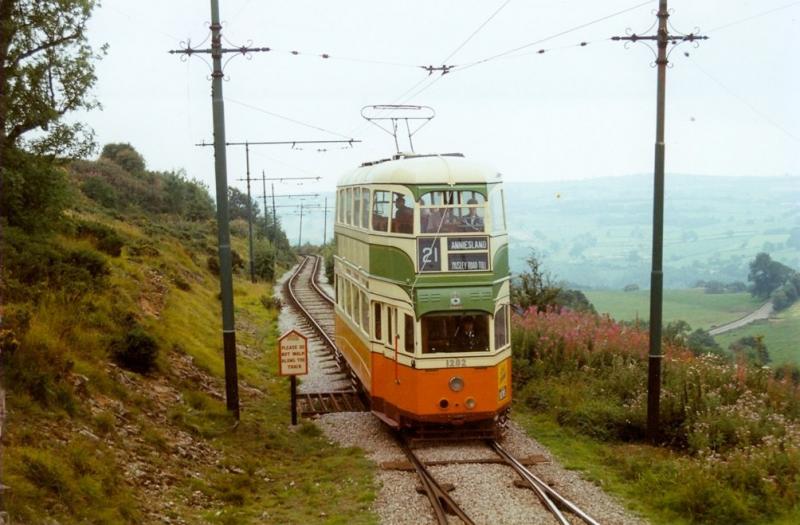
As far as 360 degree thing goes think we are confusing the number of degrees in a circle with the compass bearing. The tram will go through 360 Degrees but will end up at 180 degrees to its path. We both know what you mean but are getting bogged down with the words.
Regards
Jim
 Last edit: by The Bankie
Last edit: by The Bankie
Because, except in some unfortunate circumstances, trains did not run on town centre streets
Posted
Full Member
Card Tram
freelance model railways and tramways
index02
index02
Posted
Full Member
Just ordered a bow from John at East Lancs Tramways so I can soon tell you if the bows will flip in 00. The one on my Coronation is a vintage job and will not flip so I am interested in seeing what the current ones will do.
Does anyone else run a Bachman Hong Kong tram? I am finding that it is stalling on my test track but moving it sideways seems to set it off. This suggests that it is not all wheel pick up and that the length of the truck is allowing sideways movement and shifting the contact away from the rails. I anticipate an improvement when the bow arrives but I do not intend to dismantle the car before then.
In the meantime here's how Provenmill is currently looking.
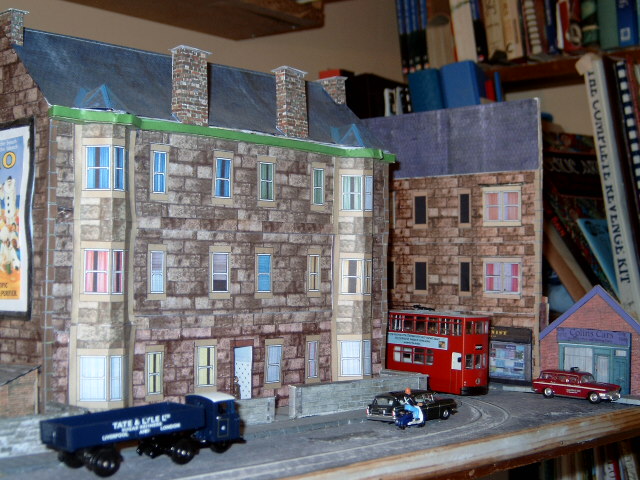
Looking East down Shirt Street to the junction with North end of High St.
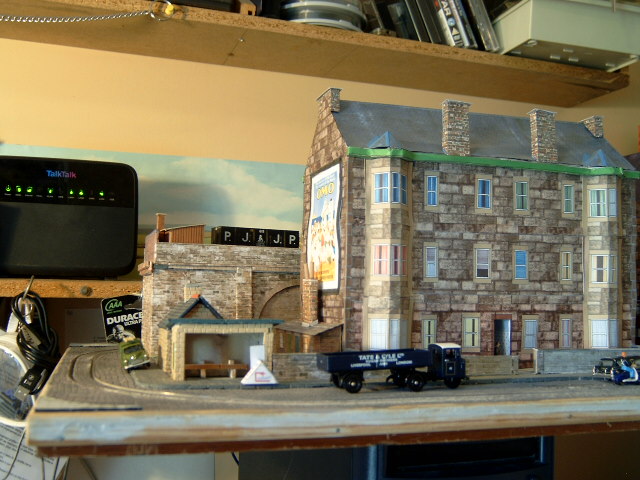
Looking North down Auchtermucty Lane.
I'll get some better pics when the overhead is in and some more work has been done.
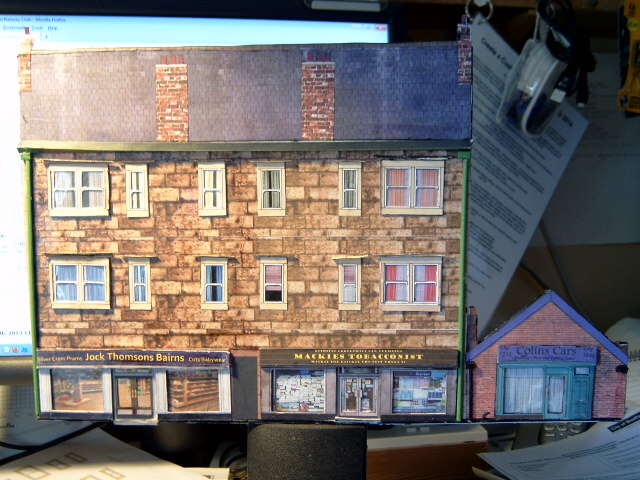
Above is the micro relief (it's 4mm thick) of High Street. Partly Scalescenes and partly my own. It just stops the tenement in Shirt Street from being an island.
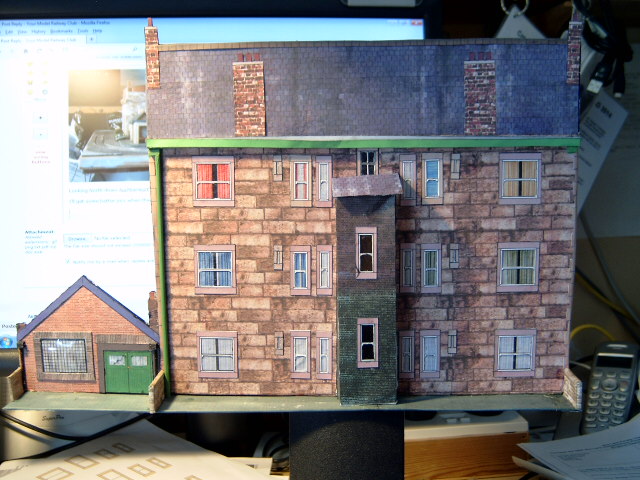
And this is the rear of High Street.
Updates as they happen.
OK No sooner had I posted this than the snail mail postman delivered my fittings from East Lancs Tramways.
Thanks for the prompt service John.


I can now confirm that IF I can solder the kit together correctly (it's not difficult but I may need a microscope) then the bow collector will flip. Details when I've sorted the bow and tram and got it running.
Jim
 Last edit: by The Bankie
Last edit: by The Bankie
Because, except in some unfortunate circumstances, trains did not run on town centre streets
Posted
Full Member
you said
The biggest prototype for a centre power rail system was London and it completely buried the power cables. Both positive & return as in the illustration below.Consequently my 'test track' layout will initially be 'wireless'. Not sure if putting in a centre rail will be easier than installing an overhead, but it will be different.
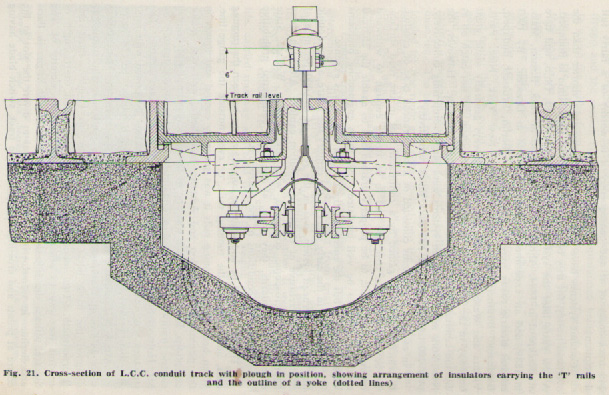
but it is questionable whether it will simplify any pointwork on a layout as illustrated below.
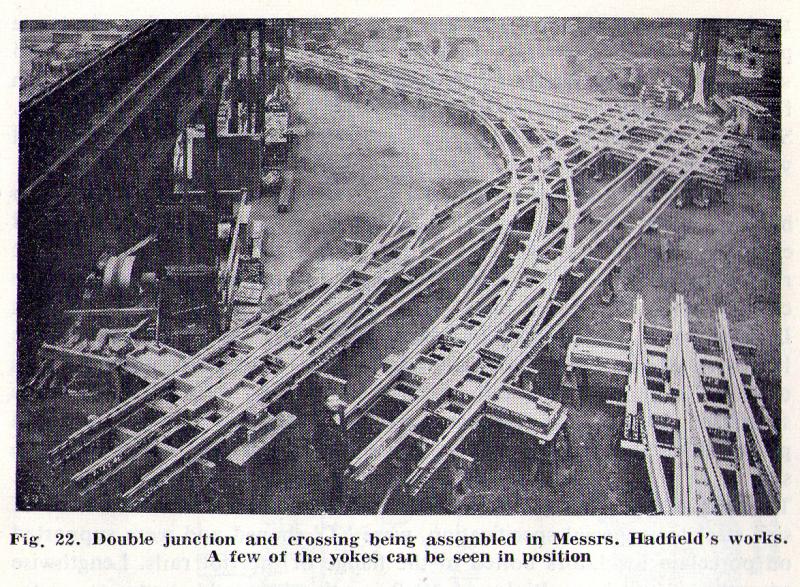
Let us know how you get on.
Regards
Jim
Because, except in some unfortunate circumstances, trains did not run on town centre streets
Posted
Site staff

Regards
Alan
Born beside the mighty GWR.
Alan
Born beside the mighty GWR.
Posted
Full Member
The images are from an out of print book "The British Tram" dated 1963, cover price 5/-. The author is Frank E Wilson and publisher Percival Marshal now acquired by MAP but no longer in their catalogue.
Mr Wilson did not record any copyright details and as he was born in 1905 I do not believe I, or YMR, to be infringing his copyright.
Obviously if you think there is a problem I will happily remove the pictures.
Sorry for the hiccough.
Regards
Jim.
Because, except in some unfortunate circumstances, trains did not run on town centre streets
Posted
Full Member
This is a lovely little piece of work. Simple (only nine parts) of which six are the mounting screws, nuts and washers and only one part needs to be soldered. You can reinforce some of the folds with solder if you wish.
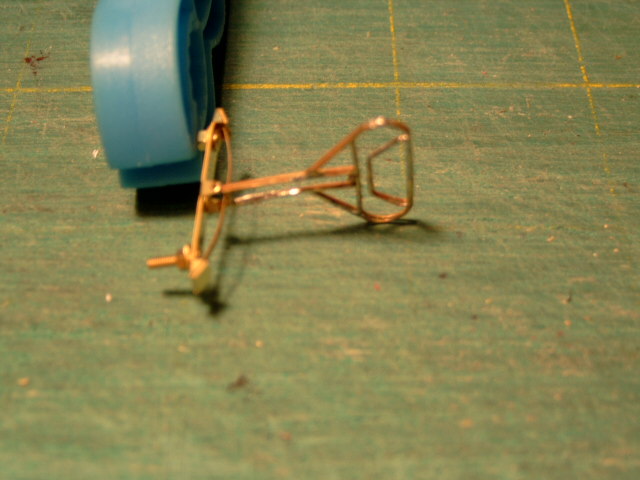
What you get is a delicate, but not in the easily damaged meaning, bow collector which is simple and efficient as either a working current collector or as a cosmetic extra.
It will flip to allow reversing and has the advantage of simplicity ensuring less chance of wear or accidental damage.
The blue clip gives an indication of scale. It's a standard freezer bag clip.
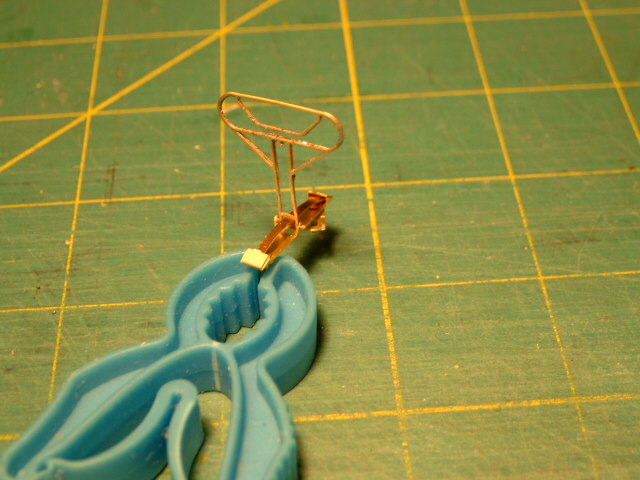
Would I recommend this kit?
Yes, IF, you can solder.
Regards
Jim.
Because, except in some unfortunate circumstances, trains did not run on town centre streets
Posted
Full Member
Just got back from a day at Crich and now can confirm that the bow collectors as used in the UK were not rotating ones and were definitely flip over with the conductor assisting by pulling the rope.
Peter, seems that the Leeds bows were better made than the Glasgow ones as they were welded and the Glasgow ones were riveted, Clydeside ship production in the 40s and 50s practice I suppose.
Regards
Jim
Because, except in some unfortunate circumstances, trains did not run on town centre streets
1 guest and 0 members have just viewed this.

